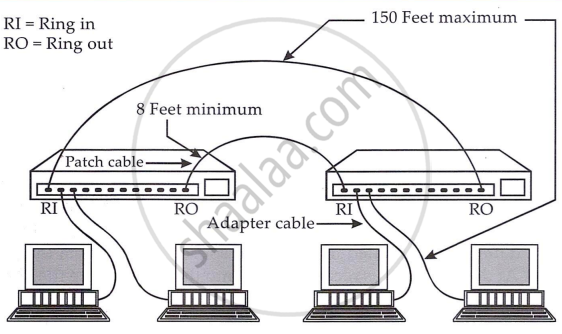Topics
Introduction to Microprocessors and Organization of 8085
Instruction Set and Programming of 8085
Introdcution to Inted X-86 Family
Introduction to Microcontroller
Networking Technology
- Introduction to Networking
- Types of Networks
- Multiplexing
- Study of Transmission media
- Coaxial cable (Cable Media)
- Twisted pair cable
- Fiber Optic Cable
- Unbounded (Wireless) Media
- Access Methods
- Network Topologies
- Ethernet (Network Architectures)
- Token-Ring (Network Architectures)
- Internet protocols
- Introduction to connectivity devices
- Token ring cabling
- Passing data on token rings
- Token ring frame
Token-Ring (Network Architectures)
Token ring uses a token - passing architecture. The topology is physically a star, but it uses a logical ring to pass the token from station to station. Each node in token ring is attached to a concentrator called a multistation access unit (MSAU or MAU). Because of MSAU, a single computer failure does not stop the whole network.
Token ring cabling
Traditionally, token ring uses twisted pair cables. The standard IBM cable types are:
Type 1: Uses two twisted pairs of solid copper wire with a braided shield for terminal and panel connections. Max distance: 101 meters (331 feet). Utilizes two STPs.
Type 2: Uses six twisted pairs (two STPs, four UTPs) for voice and data. Max distance: 100 meters.
Type 3: Uses UTP copper with two twists per inch. Lower cost but slower signal speed. Max distance: 45 meters.

Passing data on token rings
A token circulates around the token ring, and the computer holding it controls the transmission medium. The process is as follows:
- A computer captures the token.
- If it has data to send, it transmits a data frame while holding the token.
- Each computer checks if it is the intended recipient.
- The destination computer copies the frame, updates the status, and returns the frame to the ring.
- The sender receives the frame, acknowledges successful transmission, removes it from the ring, and releases the token back onto the ring.
Token ring frame

Start delimiter: Indicates the start of the frame.
Access control: Specifies frame priority and identifies if it's a token or data frame.
Frame control: Contains media access control info.
Destination address: Receiving computer's address.
Source address: Sending computer's address.
Data: The transmitted data.
Frame check sequence: Error-checking data (CRC).
End delimiter: Marks the frame's end.
Frame status: Confirms if the destination was found and the frame recognized.
